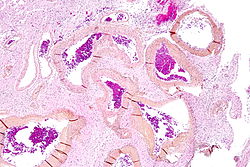Arteriovenous malformation

Editor-In-Chief: Prab R Tumpati, MD
Obesity, Sleep & Internal medicine
Founder, WikiMD Wellnesspedia &
W8MD medical weight loss NYC and sleep center NYC
| Arteriovenous malformation | |
|---|---|

| |
| Synonyms | AVM |
| Pronounce | N/A |
| Specialty | N/A |
| Symptoms | Headache, seizures, neurological deficits |
| Complications | Intracerebral hemorrhage, stroke |
| Onset | Congenital |
| Duration | Lifelong |
| Types | N/A |
| Causes | Congenital disorder |
| Risks | Family history, genetic disorders |
| Diagnosis | MRI, CT scan, Cerebral angiography |
| Differential diagnosis | Cavernous hemangioma, Dural arteriovenous fistula |
| Prevention | N/A |
| Treatment | Surgical resection, Endovascular embolization, Stereotactic radiosurgery |
| Medication | N/A |
| Prognosis | Variable, depending on size and location |
| Frequency | 1 in 100,000 per year |
| Deaths | 1% per year risk of hemorrhage |
Abnormal connection between arteries and veins


An arteriovenous malformation (AVM) is an abnormal connection between arteries and veins, bypassing the capillary system. This vascular anomaly is typically congenital, meaning it is present at birth, but it can also develop later in life. AVMs can occur in various parts of the body, including the brain, spine, lungs, and skin.
Pathophysiology[edit]
AVMs are characterized by a complex, tangled web of arteries and veins. Normally, arteries carry oxygen-rich blood from the heart to the body, and veins return oxygen-depleted blood back to the heart. In an AVM, the direct connection between arteries and veins disrupts this process, leading to potential complications such as bleeding or reduced oxygen delivery to tissues.
Symptoms[edit]
The symptoms of an AVM depend on its location. In the brain, AVMs can cause headaches, seizures, or neurological deficits. Spinal AVMs may lead to back pain, weakness, or paralysis. Pulmonary AVMs can result in shortness of breath or cyanosis. Cutaneous AVMs may appear as red or purple lesions on the skin.
Diagnosis[edit]
AVMs are often diagnosed using imaging techniques such as magnetic resonance imaging (MRI), computed tomography (CT) scans, or angiography. These methods help visualize the abnormal blood vessels and assess the risk of complications.
Treatment[edit]
Treatment options for AVMs vary based on their size, location, and symptoms. They may include:
- Surgical resection: Removing the AVM through surgery.
- Endovascular embolization: Injecting materials to block the abnormal vessels.
- Stereotactic radiosurgery: Using focused radiation to shrink the AVM.
Prognosis[edit]
The prognosis for individuals with an AVM depends on several factors, including the AVM's size, location, and whether it has bled. Untreated AVMs in the brain have a risk of bleeding, which can lead to serious complications or death.
See also[edit]
Ad. Transform your life with W8MD's Budget GLP-1 injections from $75


W8MD offers a medical weight loss program to lose weight in Philadelphia. Our physician-supervised medical weight loss provides:
- Weight loss injections in NYC (generic and brand names):
- Zepbound / Mounjaro, Wegovy / Ozempic, Saxenda
- Most insurances accepted or discounted self-pay rates. We will obtain insurance prior authorizations if needed.
- Generic GLP1 weight loss injections from $75 for the starting dose.
- Also offer prescription weight loss medications including Phentermine, Qsymia, Diethylpropion, Contrave etc.
NYC weight loss doctor appointmentsNYC weight loss doctor appointments
Start your NYC weight loss journey today at our NYC medical weight loss and Philadelphia medical weight loss clinics.
- Call 718-946-5500 to lose weight in NYC or for medical weight loss in Philadelphia 215-676-2334.
- Tags:NYC medical weight loss, Philadelphia lose weight Zepbound NYC, Budget GLP1 weight loss injections, Wegovy Philadelphia, Wegovy NYC, Philadelphia medical weight loss, Brookly weight loss and Wegovy NYC
|
WikiMD's Wellness Encyclopedia |
| Let Food Be Thy Medicine Medicine Thy Food - Hippocrates |
Medical Disclaimer: WikiMD is not a substitute for professional medical advice. The information on WikiMD is provided as an information resource only, may be incorrect, outdated or misleading, and is not to be used or relied on for any diagnostic or treatment purposes. Please consult your health care provider before making any healthcare decisions or for guidance about a specific medical condition. WikiMD expressly disclaims responsibility, and shall have no liability, for any damages, loss, injury, or liability whatsoever suffered as a result of your reliance on the information contained in this site. By visiting this site you agree to the foregoing terms and conditions, which may from time to time be changed or supplemented by WikiMD. If you do not agree to the foregoing terms and conditions, you should not enter or use this site. See full disclaimer.
Credits:Most images are courtesy of Wikimedia commons, and templates, categories Wikipedia, licensed under CC BY SA or similar.
Translate this page: - East Asian
中文,
日本,
한국어,
South Asian
हिन्दी,
தமிழ்,
తెలుగు,
Urdu,
ಕನ್ನಡ,
Southeast Asian
Indonesian,
Vietnamese,
Thai,
မြန်မာဘာသာ,
বাংলা
European
español,
Deutsch,
français,
Greek,
português do Brasil,
polski,
română,
русский,
Nederlands,
norsk,
svenska,
suomi,
Italian
Middle Eastern & African
عربى,
Turkish,
Persian,
Hebrew,
Afrikaans,
isiZulu,
Kiswahili,
Other
Bulgarian,
Hungarian,
Czech,
Swedish,
മലയാളം,
मराठी,
ਪੰਜਾਬੀ,
ગુજરાતી,
Portuguese,
Ukrainian